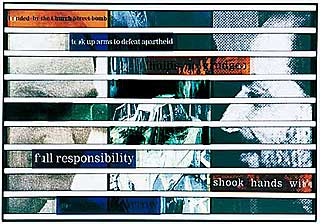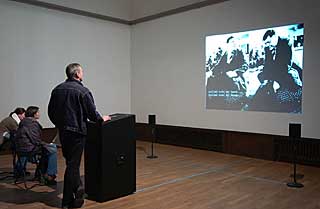

Neville Clarence - hold no grudge - Aboobaker Ismael, 1998, Laminated colour laser prints, wood, metal, plastic, perspex, 80 X 120 X 6cm |

UE WILLIAMSON occupies an influential and highly respected position in the South African art world, not only for her formidable artistic talent but also for her long history as a writer and cultural worker. The main thread connecting her art is an ability to bring the marginalized into the mainstream consciousness of society, to make visible the unseen and thereby record for posterity that which might otherwise be overlooked. Her sharp artistic eye picks out what jaded familiarity obscures for others. In this incisive way, Williamson sheaves away layers of illusion to re-present reality in a fresh light. In the 1980s, Williamson was well known for her series of portraits of women involved in the country's political struggle. A Few South Africans went some way towards filling the representational void of people and events during apartheid. And in many ways, her recent video work focusing on South African immigrants is a return to this concern. Williamson also contributes to South African society through her literary talents. She is the published author of two respected books - Art in South Africa: the Future Present and Resistance Art in South Africa - and an art critic and founder of Art Throb. Her first career as a journalist and subsequent move into copy writing for the advertising industry provided good grounding. She says: "You become aware of the audience to whom you speak. In that sense, you think backwards: what you have to say, whom you say it to, and how it will reach the audience. Having to consider your work through the eyes of somebody who knows nothing about you as an artist and what you are doing is a useful exercise." Founder member of arts organization Public Eye, Williamson is also a cultural organizer who contributes to many collective or group art projects. Of these various hats, she says: "I am an artist first. I am interested in the way art can change and influence things and that process is helped by writing about it. Those different roles all feed back into each other." Williamson has managed to avoid the rut of being caught in an apartheid-era aesthetic, a malaise some other South African artists have suffered. It is perhaps her relentless embrace of the new that drives this progress. She says: "I am never particularly interested in doing what I did the last time. I take one thing and work it out a number of ways." This fact is reflected in the variety of media Williamson embraces, from print to mixed media, video and site-specific installations. Kim Gurney, ArtThrob November 2003
11 - 28 May 2020
Girls Night Out
From the Inside |


